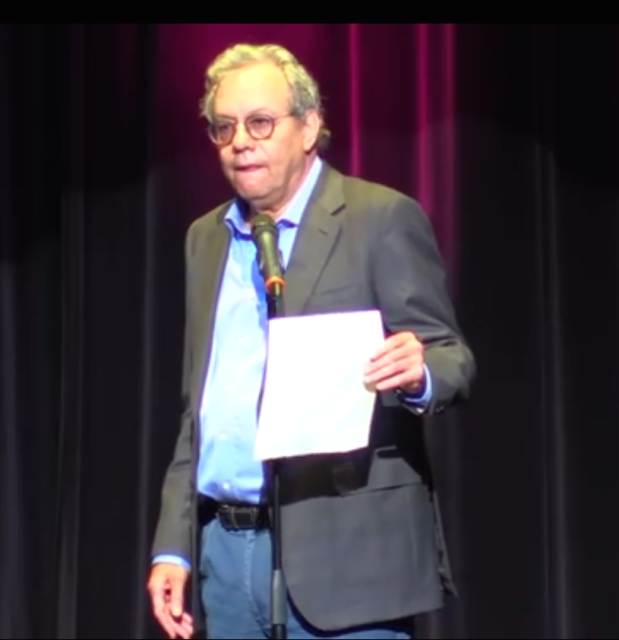 Lewis Black has become the king of the rant, and part of his comedy routine is just to allow other people to rant. They send in letters that he reads aloud with comic asides liberally dosed with profanity.
Lewis Black has become the king of the rant, and part of his comedy routine is just to allow other people to rant. They send in letters that he reads aloud with comic asides liberally dosed with profanity.
One Black video that has gotten a lot of play in the last week and a half is a letter from Trevor Sepulvida, an 18-year-old from San Diego who resigned his membership from the LDS Church as soon as he became an adult. Black read Sepulvida’s resignation letter earlier this month as part of his The Rant Is Due: Part Deux performance.
Sepulvida sent his letter to the church just before the news broke about new Mormon policies that will prevent some children of LGBT families from being baptized. But, as he says, the idea that “Jesus wants me for a Sunbeam only if my parents aren’t gay” doesn’t exactly sit well with him. (I am toning down the language significantly here, people. You’re welcome.)
In the letter, Sepulvida shows a strain of wry humor that’s similar to Black’s characteristic noir wit. “There’s a difference between eating McDonalds hamburgers and having to sell them,” Sepulvida says of his decision not to serve an LDS mission.
While I’m sympathetic to the frustration and anger Sepulvida feels about LDS policies on LGBTs and other issues, it’s worth exploring which of the claims he makes about Mormon history are factual and which are not. For example:
1. “This is the very church that institutionalized racism in both policy and scripture. It’s no coincidence that the prophet of the church received revelation about the membership of blacks the same week that President Jimmy Carter threatened the church’s tax-exempt status in 1978.”
This rumor has been around for some time now despite the lack of actual historical documentation to support it. FAIR MORMON does a debunking of the urban legend here, tracing the first time the allegation appeared in print in 2001 and exploring each piece of “evidence” of a threat from President Carter – like a photo of Pres. Carter and LDS prophet Spencer W. Kimball together.
VERDICT: False. Although there are a number of good historical reasons to think that the 1978 revelation had some human components, such as a 1974 lawsuit brought against the LDS Church’s scouting program by the NAACP (See Hawes, The Mormon Image in the American Mind, 70), there is no evidence that President Carter ever “threatened the church’s tax-exempt status in 1978.”
But bonus points should be awarded for creativity! I’ve never seen the ante upped like this by claiming that the threat occurred in “the same week” as the priesthood revelation. That’s a new one.
2. “This is the same church that institutionalizes homophobia, and continues to outwardly demonstrate how bigoted it is. Remember Prop 8? . . . I would like to see where the $20 million they spent on Prop 8 are now. Did they magically make their way to the Official Bank of Planet Kolob?”
VERDICT: False in the financial details, possibly true in the overall conclusion of bigotry. The “Church” did not spend $20 million defeating Proposition 8. In her essay on Proposition 8 in Mormonism and American Politics, author and scholar Joanna Brooks estimates that “individual Mormons contributed between 50 and 70 percent of the $40 million raised by ‘Yes on 8.’” (198)
The key distinction is that the money was donated by individual Mormons, not the LDS Church as an institution as Sepulvida’s letter implies. This may seem like a subtle difference, but try telling that to the IRS . . . .
Also, for the record, just focusing on the $20 million monetary figure also ignores the huge non-financial support that individual Mormons provided. “Acting on instruction from LDS Church leaders, LDS members had also been mobilized as precinct walkers, phone bankers, zip code area supervisors, and child care providers, in voter identification and get-out-the-vote efforts for a far-reaching and professionally orchestrated ‘grassroots’ campaign.’” (192) So in this way Sepulvida has actually underestimated Mormons’ responsibility for the passage of Prop 8.
3. “A leader of the Church actually referred to a young man’s penis as his ‘little factory’ in an anti-masturbation sermon.”
VERDICT: Totally and humiliatingly true.
Here is a link to Boyd K. Packer’s “To Young Men Only” talk from 1994.
I am still traumatized.





